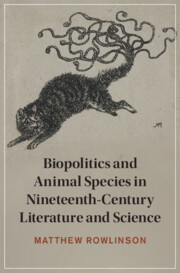109 results
Chapter 56 - Infection Control
- from Section 5 - Patient Management
-
- Book:
- Clinical and Diagnostic Virology
- Published online:
- 11 April 2024
- Print publication:
- 18 April 2024, pp 282-285
-
- Chapter
- Export citation
Chapter 6 - Knowing Nature as a God
-
- Book:
- Reconstructing Empedocles' Thought
- Published online:
- 01 February 2024
- Print publication:
- 08 February 2024, pp 246-306
-
- Chapter
- Export citation

Biopolitics and Animal Species in Nineteenth-Century Literature and Science
-
- Published online:
- 11 January 2024
- Print publication:
- 01 February 2024
Chapter 3 - The Lustful Oblivion of Widowhood in The Insatiate Countess
- from Part I - Ars memoriae, ars amatoria
-
-
- Book:
- Memory and Affect in Shakespeare's England
- Published online:
- 07 June 2023
- Print publication:
- 27 July 2023, pp 68-86
-
- Chapter
- Export citation
Chapter 11 - The Mechanics of Galen’s Theory of Nutrition
- from Part III - Towards the Mechanization of the Human Body
-
-
- Book:
- Body and Machine in Classical Antiquity
- Published online:
- 13 July 2023
- Print publication:
- 27 July 2023, pp 262-295
-
- Chapter
- Export citation
Chapter 19 - The Endocannabinoid System in Schizophrenia
- from Part VI - Cannabinoids and Schizophrenia: Aetiopathology and Treatment Implications
-
-
- Book:
- Marijuana and Madness
- Published online:
- 12 May 2023
- Print publication:
- 01 June 2023, pp 189-199
-
- Chapter
- Export citation
Chapter 29 - Fundamentals of Fluid and Electrolyte Balance during Surgery
-
-
- Book:
- Fundamentals of Operating Department Practice
- Published online:
- 18 August 2022
- Print publication:
- 08 September 2022, pp 322-333
-
- Chapter
- Export citation
Chapter 17 - Haemodynamic Monitoring
-
-
- Book:
- Fundamentals of Operating Department Practice
- Published online:
- 18 August 2022
- Print publication:
- 08 September 2022, pp 180-190
-
- Chapter
- Export citation
Introduction
-
-
- Book:
- The Cambridge Companion to American Horror
- Published online:
- 21 July 2022
- Print publication:
- 04 August 2022, pp 1-12
-
- Chapter
- Export citation
20 - Circulation and the New Physiology
- from Part III - Problems and Controversies
-
-
- Book:
- The Cambridge History of Philosophy of the Scientific Revolution
- Published online:
- 14 January 2022
- Print publication:
- 06 January 2022, pp 369-386
-
- Chapter
- Export citation
Detecting SARS-CoV-2 Orf3a and E ion channel activity in COVID-19 blood samples
-
- Journal:
- Journal of Clinical and Translational Science / Volume 5 / Issue 1 / 2021
- Published online by Cambridge University Press:
- 14 September 2021, e196
-
- Article
-
- You have access
- Open access
- HTML
- Export citation
Chapter 11 - Cardiology and Cosmology in Post-Chrysippean Stoicism
-
-
- Book:
- Cosmology and Biology in Ancient Philosophy
- Published online:
- 21 May 2021
- Print publication:
- 10 June 2021, pp 190-207
-
- Chapter
- Export citation
Chapter 7 - Disabling Freedom: Bloody Shirt Rhetoric in Postbellum Slave Narratives
- from Part II - Persons and Bodies
-
-
- Book:
- African American Literature in Transition, 1865–1880
- Published online:
- 18 March 2021
- Print publication:
- 13 May 2021, pp 161-186
-
- Chapter
- Export citation
8 - Hemorheology
-
-
- Book:
- Theory and Applications of Colloidal Suspension Rheology
- Published online:
- 07 April 2021
- Print publication:
- 15 April 2021, pp 316-351
-
- Chapter
- Export citation
1 - How Blood Marks the Bounds of the Christian Body
- from Part I - Why We See Red
-
- Book:
- Blood Theology
- Published online:
- 22 March 2021
- Print publication:
- 25 March 2021, pp 3-36
-
- Chapter
- Export citation
4 - Blood after the Last Supper
- from Part II - Blood Seeps in Where It Hardly Seems to Belong
-
- Book:
- Blood Theology
- Published online:
- 22 March 2021
- Print publication:
- 25 March 2021, pp 83-114
-
- Chapter
- Export citation
6 - Red in Tooth and Claw
- from Part III - Blood Makes a Language in Which to Conduct Disputes
-
- Book:
- Blood Theology
- Published online:
- 22 March 2021
- Print publication:
- 25 March 2021, pp 131-160
-
- Chapter
- Export citation
2 - Blood after Isaac
- from Part II - Blood Seeps in Where It Hardly Seems to Belong
-
- Book:
- Blood Theology
- Published online:
- 22 March 2021
- Print publication:
- 25 March 2021, pp 39-50
-
- Chapter
- Export citation
7 - Blood Purity and Human Sacrifice
- from Part III - Blood Makes a Language in Which to Conduct Disputes
-
- Book:
- Blood Theology
- Published online:
- 22 March 2021
- Print publication:
- 25 March 2021, pp 161-182
-
- Chapter
- Export citation
9 - The Blood of Christ and the Christology of Things
- from Part IV - The Blood of God at the Heart of Things
-
- Book:
- Blood Theology
- Published online:
- 22 March 2021
- Print publication:
- 25 March 2021, pp 201-216
-
- Chapter
- Export citation



